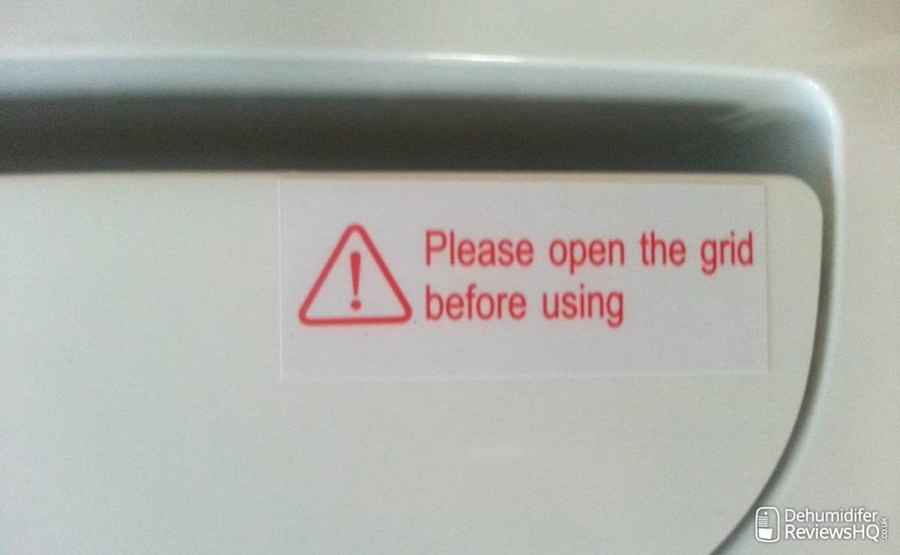The 12L is part of Meaco’s range of dehumidifiers which are intended to be well designed, easy to use and incredibly economical. But how well does it work? And it is inexpensive to run? Find out everything you need to know about the 12L in our hands-on review…

Meaco 12L – Key Product Specifications


Prices & information last updated on 2025-09-18
Meaco 12L – Basic Features & Overview
Sporting a white case with green highlights the 12L Platinum looks virtually like a smaller version of its successor, the 20L. The build is quality is just as high too. The case feels like high-grade plastic and it is incredibly solid and has no flimsy or weak parts.
We even lifted tested the quality of the air outlet grill by giving it a good press! To Meaco’s credit, this held firmly in place and appears to be made of heavy, durable plastic.
When comparing the 12L to its bigger brother the 20L there are some obvious differences. Firstly the 12L is a lot smaller and lighter. It measures 48.5cm tall by 32.5cm wide by 24.8cm deep and weighs 9.8Kg.
Secondly, there are no castors fitted to the 12L – but it doesn’t really need them. We had no problem picking up and moving the 12L. And, whilst it isn’t quite as light in the hand as Meaco’s flagship Zambezi dehumidifier, it is still reasonably light for a refrigerant dehumidifier. Although how heavy it feels from person to person is obviously quite subjective.

Thirdly is the manually adjustable louver of the 12L. It allows the airflow exiting the machine to be directed to an exact spot (for fast drying) or it can be opened up fully for overall, increased airflow. It does, however, lack the automatic motorised swinging movement featured in the 20L.
Setting the Louvre is easy and it can be adjusted, by hand, in seconds. It subtly clicks as you lift/lower it and locks firmly in place when you’re done.
It is important to make sure you have this open to some degree before you begin using the device and Meaco have handily included a nice warning sticker on the top of the Louvre to remind you to do this.
Water Collection
Around the back of the unit, you’ll find the water collection tank. There is no window on this so you can’t tell how full it is without removing it.

This isn’t a huge issue since the 12L features a tank full light, which shows you at a glance when the tank is full and automatically shuts off the machine to prevent overfilling.
Like the rest of the unit, the tank is very well constructed and the curved shape made it easy for us to hold and empty.
It is a shame there is no handle on the top but this wasn’t too much of a problem because the lid prevented any spillages. It can hold a very respectable 2.5 litres of water before it needs emptying.
Because of the 12L’s compact size, you can also set it on a worktop, next to a sink, and employ the continuous drainage option. This means you won’t need to worry about emptying the tank. Although you will need to get the correct size and length of tube since one isn’t supplied with the appliance.
Meaco Control Logic
This smart piece of technology by Meaco makes the running costs of the 12L very cheap. Essentially it makes sure the dehumidifier is only operating when it is needed and puts it into sleep mode when it’s not.
If the humidity falls 3% below the set threshold for 10 minutes over the unit knows it is not needed and goes to sleep. It will then wake up every 30 minutes, test the air and begin operating if needed or go back to sleep if not.
This technology, when combined with other moneys saving features of the 12L, allows this dehumidifier to run for as little as 2.5p an hour (based on 15.32p/kWh).
Controls

For anyone who has read our review on the Meaco 20L, you’ll see that the 12L has virtually the same, albeit cut down, control panel. Featuring soft press, blister buttons and function-indicator lights it is easy to use. We found it simple to setup and use in seconds without consulting the manual.
There are a total of 4 buttons on the panel. A bank of 4 indicator lights and a small, but perfectly visible LCD screen. To give you a real overview of what you can expect from the 12L we’ll take a look at each in turn…
1) Timer Button
The leftmost side of the panel is home to the timer button. As we’ve mentioned in previous reviews, this handy little feature allows you to keep control over the running costs.
But, how? Well, damp doesn’t follow our daily schedule. So, if you need to combat damp in your home whilst you’re at work, but don’t want the dehumidifier to be running all day, simply set the timer and allow it to work. Safe in the knowledge it will automatically shut off after the time you’ve specified, help with eliminating damp and not cost a small fortune doing it!
Pressing the timer button once will cause it to flash. You can then use the ‘up’ and ‘down’ arrow keys to set the timer from 1 to 24 hours.
2) Up/Down Arrow Buttons
Next, on the panel are the arrows keys. By default, these allow you to set the target relative humidity (RH) level threshold in handy 5% intervals ranging from CO (Continuous Operation) right up to 80%. (Although, as mentioned above, they are also used to set the timer).
For most homes, we’d recommend setting the RH at 55%. However, on colder days, or for more severe damp problems, you may need to lower this to 45% to achieve a damp and condensation free home.
This is a very handy feature because you can precisely set the target RH level. This is far superior to many other dehumidifiers in this price bracket which only offer three general settings – low, med or high.
3) Child Lock
One more feature worth mentioning is the child lock. This isn’t common to dehumidifiers, but is a really good idea, because little hands like to explore everywhere! Pressing the up and down arrows simultaneously will lock all of the controls. Doing the same again will unlock them.
Finally we reach the power button – no explanation needed for this one!
Feedback
One of the most remarkable things about the 12L is just how sophisticated its feedback system is for a mid-range dehumidifier. Many units in the 12L’s price bracket limit themselves to one light which can be used to represent a variety of functions – and some have none at all.
This means, with the 12L, you can literally see at a glance what the dehumidifier is doing and if it needs your attention. It doesn’t sound like an important consideration. But, this is important early-on and allows you to see, at a glance, how effective the dehumidifier is in tackling damp and excess moisture.
1) Defrost Mode

The leftmost light is the defrost mode light. When illuminated it means the temperature of the room is too low for the dehumidifier to operate. To prevent ice from forming in the machine and to increase its efficiency the 12L will periodically switch off its cooling system and only run the fan – this is defrost mode.
2) Timer Mode
3) LCD Display
Following on from the timer is the segmented LCD display. This is, in our opinion, the best part!
Using the 12L’s internal hygrometer the display shows the current RH level of the room. You can see this drop, over time, as the dehumidifier is working and it gives you a real sense of how damp your room was and just how much it has dried out whilst the unit has been active.
4) Tank Full & Dehumidification Lights
Finally, we reach the tank full and dehumidification light. The first will obviously illuminate when the water collection tank is full and the second illuminates whilst the unit is actively collecting water from the air.
Performance

The 12L is not designed to be a powerhouse of a unit and is ideally suited to flats and homes with up to 3 bedrooms. As such, we more gentle with our testing than with other beefier dehumidifiers such as the Zambezi or 20L.
We placed the unit in a kitchen after raising the humidity to 86%. This was achieved by gently boiling pans of water to simulate cooking.
For its size and power, it did a remarkably good job at lowering the humidity to around 63% in around 30 minutes. After another 20 minutes, the 12L held the RH in the late 50’s reasonably comfortably. Especially since the temperature of the room was only around 19 degrees.
When compared to the 20L the reduction in humidity wasn’t as fast. But, this comes as no surprise given the difference in power. In addition, when compared to other dehumidifiers we’ve tested within the same price range, the 12L excels.
For example, when compared to a similar offering by Ebac the 12L comes out on top. In the same test period, the 12L is able to reduce the humidity and remove condensation from the windows. Ebac’s 2650e was unable to achieve this in the same time period.
The only real shortcoming we noted was the lack of fan speed settings. It meant that we were unable to get an extra boost in power when needed. The upside to this is it keeps the 12L’s running costs very low. In fact, it costs only 2.5p per hour to run (based on 15.3pkWh) making it a dehumidifier with one the cheapest running costs available today.
12L Platinum Pros and Cons
What We Think About The Meaco 12L Low Energy:
The 12L Platinum is incredibly effective for a dehumidifier of its size and power and it outperformed other units we’ve tested of the same class. It should have no problem keeping mild damp and condensation at bay in small homes. It’s high build quality, ease of use and low running costs impressed us highly and we believe Meaco have made yet another winning model.
However, for those of you who still want the features of the 12L, but with more power for larger homes and damp problems you might want to check out the 20L Platinum before settling on the 12L.





